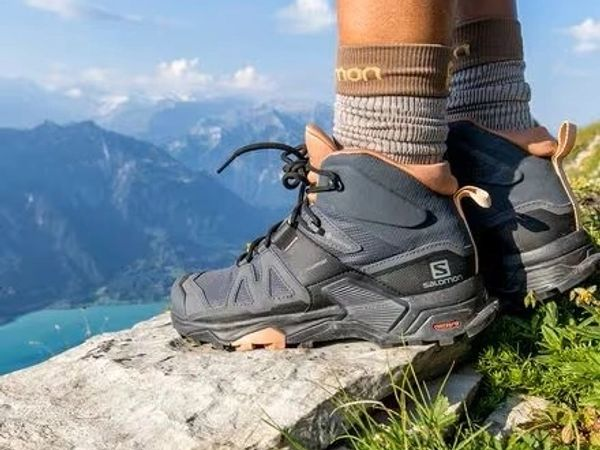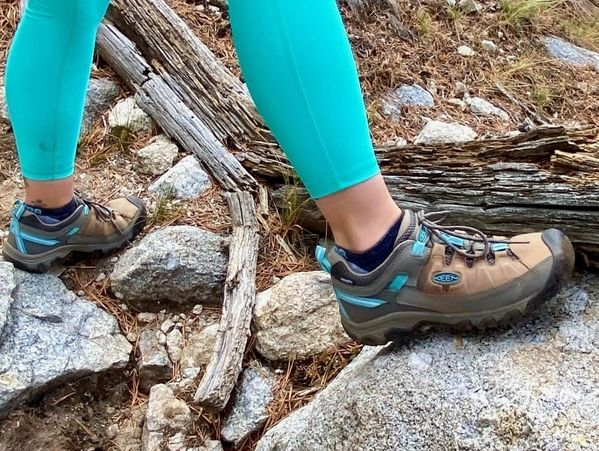gear Reviews Made Simple
Best Women’s Hiking Boots Guide | Cap Puckhaber
Disclaimer: I DO NOT EARN ANY COMMISSIONS FOR RECOMMENDING THESE PRODUCTS.
Your Hiking Boot Guide for Women
Cap Puckhaber here. As a guy who spends a lot of time on the trail, I know how important it is to have the right gear. Because of this, I understand that when it comes to boots, it’s not just about durability and performance. Instead, it’s about finding a pair that feels like an extension of your own feet. For the women out there, the options can be overwhelming. Therefore, you need a boot that’s not only comfortable and lightweight but also built to handle whatever the trail throws your way. That’s why I put together this guide to help you find the best women’s hiking boots on the market.
Matching the Boot to Your Adventure
The first question I always ask is, “What kind of trails are you hitting?” The answer immediately narrows the options. In my experience, choosing between a flexible shoe and a sturdy boot is the most critical starting point. Both have their place on the trail.
Hiking Shoes for Lighter, Faster Trails
Think of hiking shoes as the athletic, nimble option. They are typically low-cut, sitting below the ankle, which allows for maximum flexibility. Their lighter weight means less fatigue on well-maintained paths or during fast-paced day hikes. Most prioritize breathability, often using mesh panels to keep your feet cool and dry from the inside out. They are the perfect tool for shorter adventures where heavy-duty support isn’t the primary concern.
Hiking Boots for Support and Stability
When your pack gets heavier or the terrain becomes rugged and unpredictable, a true hiking boot is what you need. These are built with mid or high-cut uppers to provide crucial ankle support, preventing twists on rocky or uneven ground. Their midsoles are generally stiffer, which stops your feet from fatiguing by wrapping over every rock and root. While often heavier and less breathable due to waterproof membranes and durable materials, their stability and protection are non-negotiable for serious backpacking or challenging conditions.
Decoding the Anatomy of a Hiking Boot
Understanding what a boot is made of is how you move from a good choice to the perfect one. Every material and component serves a purpose, contributing to the boot’s overall weight, durability, and on-trail performance. I’ve learned to look past the brand name and focus on these core elements.
The Uppers: Your First Line of Defense
A boot’s upper material dictates its breathability, durability, and water resistance. Full-grain or nubuck leather offers unmatched toughness and abrasion resistance but requires a break-in period. For a lighter, more breathable option that’s ready to go right out of the box, a combination of split-grain leather and synthetics like nylon mesh is an excellent choice. Many boots also include a waterproof membrane like GORE-TEX®, which is fantastic for wet conditions but can reduce breathability on hot days.
The Midsole: The Engine of Comfort
The midsole is the unseen hero of a hiking boot. It provides cushioning, absorbs shock, and determines the boot’s stiffness. Most are made from EVA, which is lightweight and cushy, or polyurethane, which is firmer and far more durable. For long hikes with a heavy pack, a stiffer boot with a firm polyurethane midsole and internal supports called shanks or plates is a lifesaver. It prevents your feet from feeling every sharp rock and provides a stable platform, conserving your energy over miles.
The Outsole: Where Rubber Meets the Trail
The outsole is your connection to the earth. Look for a pattern of deep, widely-spaced bumps called lugs; these provide critical traction on everything from mud to loose gravel. Another feature I always check for is the heel brake—a distinct, sharp angle on the heel of the sole. This feature acts like a brake, digging in to give you more control and prevent sliding during steep descents. It’s a small detail that makes a massive difference in your confidence and safety.
Getting the Fit Right: The Foundation of a Great Hike
All the technology in the world means nothing if the boot doesn’t fit your foot correctly. Blisters and discomfort can ruin a trip faster than anything else. This is the one area where you cannot compromise.
How to Try on Boots Like an Expert
The process for finding the right fit is methodical, and it works. First, always shop in the afternoon or evening when your feet have naturally swelled. Second, bring the exact socks you plan to hike in, as their thickness drastically affects fit. If you use custom orthotics, bring those, too.
When you slide your foot in, it should feel snug everywhere but tight nowhere. Before lacing up, push your foot forward until your toes touch the front; you should be able to slip one finger between your heel and the back of the boot. After lacing, your heel should be locked in place with minimal lift, and you should have enough room to freely wiggle your toes.
Troubleshooting and Final Checks
Walk around the store, preferably on an incline ramp if available. Pay attention to any pinching across the width of your foot or your toes hitting the front on the decline—both are dealbreakers. If your foot feels like it’s swimming in the boot despite tight laces, the boot has too much volume for you. Don’t assume a boot will “break-in” to fix a poor fit. A great boot should feel good from the start, only getting better with time.
The Right Boots Make All the Difference
Whether you’re hitting a quick local loop with the dog, tackling a rocky mountain pass, or preparing for a multi-day backpacking trip, the right boot makes all the difference. This isn’t just a list of my favorites. On the contrary, these are boots I’ve seen on the trail, talked to fellow hikers about, and researched for their performance, durability, and most importantly, comfort. Ultimately, we’ll cover options for different skill levels, foot types, and budgets so you can make an informed decision and get out on the trail with confidence.
Salomon: The All-Around Performer for Tough Trails
If you’re an experienced hiker who tackles challenging, rocky, and technical trails, the Salomon X Ultra 4 GTX Hiking Boots are a top contender for the best women’s hiking boots. Salomon is a brand synonymous with quality and performance. These boots are designed to be agile and supportive, letting you move quickly and with stability on uneven ground.
Salomon X Ultra 4 GTX: Built for Agility and Grip
These boots are packed with features that make them a favorite among serious hikers. The GORE-TEX lining ensures your feet stay dry when you’re crossing streams or navigating muddy sections. The Contagrip® MA outsole provides superior traction on everything from wet rocks to slippery mud. What really sets them apart is the Advanced Chassis system, which enhances stability without adding unnecessary bulk, so you can focus on the trail ahead.
- Best for: Experienced hikers taking on challenging terrain.
- Why I Like Them: The balance of lightweight feel and serious stability is hard to beat.

Merrell: The Classic Choice for Comfort and Versatility
The Merrell Moab 3 Mid Waterproof Hiking Boots are legendary in the hiking community, and for a good reason. The Moab series has a reputation for being incredibly comfortable right out of the box. They hit a sweet spot between durability and affordability, making them a great choice for both new and experienced hikers.
Merrell Moab 3 Mid: A Go-To for Any Trail
These are boots you can wear on a city walk and then take straight to a moderate trail. The M Select™ DRY technology provides reliable waterproof protection while maintaining breathability. The Vibram® sole is a well-known name in the industry for its durability and excellent grip on various surfaces. Plus, the Air Cushion in the heel absorbs shock and provides a stable, cushioned feel.
- Best for: Hikers of all skill levels who need a versatile boot for trails and everyday use.
- Why I Like Them: You can’t go wrong with the Moab. It’s a reliable, comfortable workhorse of a boot.

Columbia: An Excellent Budget-Friendly Option
For those just starting their hiking journey or anyone on a tight budget, the Columbia Newton Ridge Plus Waterproof Amped Hiking Boots offer solid performance without the high price tag. Finding quality gear at an affordable price is crucial, and these boots deliver.
Columbia Newton Ridge Plus: Affordable Quality
Don’t let the price fool you. These boots are built to perform on the trail. The Omni-Tech waterproofing will keep your feet dry in damp conditions, while the Techlite® lightweight midsole provides exceptional cushioning and energy return. The Omni-Grip™ rubber outsole gives you reliable traction on a variety of surfaces. These are a fantastic entry-level option that will help you build confidence on the trail.
- Best for: Beginners and casual hikers looking for a quality, affordable boot.
- Why I Like Them: They prove that you don’t have to spend a fortune to get a great pair of hiking boots.

La Sportiva: Precision for Narrow Feet
Finding a hiking boot that fits a narrow foot snugly without causing blisters can be a serious challenge. The La Sportiva Nucleo High GTX is a premium boot designed to solve that problem. It offers a precise, secure fit and high-level performance for rugged terrain.
La Sportiva Nucleo High GTX: A Precise, Technical Fit
The GORE-TEX® Surround™ technology is a game-changer, providing 360-degree waterproofing and breathability, making them comfortable in varying weather conditions. The Vibram® outsole, designed in-house, offers fantastic grip on steep and rocky trails. This boot is made for performance, and the compression-molded EVA midsole provides excellent shock absorption for long days on the trail.
- Best for: Women with narrow feet seeking a precise, high-performance boot for rugged trails.
- Why I Like Them: They are a top-tier option for a specific fit challenge, proving that there’s a boot for every foot.

Keen: Comfort and Space for Wider Feet
On the other side of the spectrum, women with wide feet often struggle to find a boot that provides a roomy toe box without sacrificing support. The Keen Targhee III Waterproof Hiking Boots have a reputation for being one of the most comfortable options for wider feet.
Keen Targhee III: The Wide-Foot-Friendly Favorite
Keen is a brand well-known for its comfort-first approach, and the Targhee III continues that legacy. The KEEN.Dry waterproofing system keeps your feet dry while allowing for breathability. The boots are built with an ESS shank for stability and the signature spacious toe box that makes them so popular. This combination of comfort and stability makes them a top choice for all-day use.
- Best for: Women with wide feet or anyone prioritizing all-day comfort.
- Why I Like Them: The focus on a comfortable, roomy fit without sacrificing trail performance is a big win.

Oboz: Built for the Long Haul
If you’re planning multi-day hikes or tackling tough, rugged trails, you need a boot that can go the distance. The Oboz Bridger Mid B-Dry Hiking Boots are designed for endurance, combining durability, comfort, and support for long-distance treks.
Oboz Bridger Mid B-Dry: The Long-Distance Workhorse
These boots are constructed for the long haul. The B-Dry waterproofing keeps your feet dry even in sustained wet conditions, and the high-performance outsole provides adept traction on rocky and muddy terrain. The O FIT Insole™ is a standout feature, providing exceptional foot support and cushioning that helps reduce fatigue on long hikes. This is a robust boot built to withstand heavy use and high mileage.
- Best for: Experienced hikers and long-distance adventurers.
- Why I Like Them: They are built for serious mileage and deliver on support and durability.

Conclusion: Lacing Up Your Next Adventure
Choosing the best women’s hiking boots is a personal decision that comes down to your unique feet, hiking style, and the trails you plan to explore. I’ve been a marketer for years, so I understand the importance of making an informed choice. I’ve tried to put that same focus on this guide. My goal is to help you find a boot that not only performs but also feels like it was custom-made for you.
Remember to consider what’s most important for you: Do you need a lightweight option for agility? Is waterproofing a top priority? Do you need a specific fit for narrow or wide feet? By asking yourself these questions, you’ll be well on your way to finding the perfect pair. The right boots will make a world of difference, allowing you to focus on the beauty of the trail instead of on your feet.
Happy hiking!
More Blogs from Cap Puckhaber

Follow Cap Puckhaber on Social Media


Cap Puckhaber
Backpacker, Marketer, Investor, Blogger, Husband, Dog-Dad, Golfer, Snowboarder
Cap Puckhaber is a marketing strategist, finance writer, and outdoor enthusiast from Reno, Nevada. He writes across CapPuckhaber.com, TheHikingAdventures.com, SimpleFinanceBlog.com, and BlackDiamondMarketingSolutions.com.
Follow him for honest, real-world advice backed by 20+ years of experience.